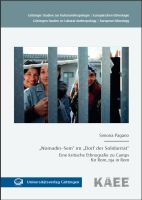„Nomadin-Sein“ im „Dorf der Solidarität“ - Eine kritische Ethnografie zu Camps für Rom_nja in Rom
| dc.contributor.author | Pagano, Simona, | |
| dc.date.accessioned | 2019-12-05 03:00:28 | |
| dc.date.accessioned | 2020-04-01T09:23:44Z | |
| dc.date.available | 2020-04-01T09:23:44Z | |
| dc.date.issued | 2019 | |
| dc.identifier | 1006517 | |
| dc.identifier | OCN: 1135848308 | en_US |
| dc.identifier.uri | http://library.oapen.org/handle/20.500.12657/23629 | |
| dc.description.abstract | In Italy, Solidarity Villages are state-provided places of accommodation for Romani people. In Rome, they are typically fenced off areas equipped with low-quality portable housing. In the media, these halting sites are often represented as a culturally appropriate housing solution. Yet, these camps are neither temporary halting places nor cultural forms of housing. Rather, they are places of segregation, conflict and negotiation—sites where racism, sexism and a particular way of dealing with poverty and migration condense. Beginning with the declaration of a Nomad Emergency in 2008, Simona Pagano documents the emergence of the spatial logic of the camp and offers an intersectional analysis of the complex power relations that shape the lives of its female residents. Drawing on ethnographic engagement, as well as interviews with institutional actors and civil society organizations, Pagano shows that the camps are often places of segregation and control, of profit generation and violence, but also, spaces of solidarity, homemaking and friendship. | |
| dc.language | German | |
| dc.subject.classification | thema EDItEUR::J Society and Social Sciences | en_US |
| dc.subject.other | Romani | |
| dc.subject.other | segregation | |
| dc.subject.other | camps | |
| dc.title | „Nomadin-Sein“ im „Dorf der Solidarität“ - Eine kritische Ethnografie zu Camps für Rom_nja in Rom | |
| dc.type | book | |
| oapen.abstract.otherlanguage | Als Dörfer der Solidarität werden insbesondere in Rom, meist mit Wohncontainern ausgestattete, eingezäunte Camps bezeichnet, in denen Rom_nja und Sint_izze institutionell untergebracht werden. Medial sind diese vielbeachtet, die Bewohner_innen werden stereotypisiert noch immer als „Nomaden“ kategorisiert, die als solche spezifischer Wohnmöglichkeiten - nämlich ihrer Halteplätze - bedürfen. Doch sind diese Camps weniger Halteplätze und kulturell spezifische Wohnform, als vielmehr Orte der Segregation sowie Konflikt- und Aushandlungsräume. In ihnen verdichten sich unterschiedliche Machtverhältnisse, wie Rassismus und Sexismus, aber auch ein spezifischer Umgang mit Armut und Migration. Ausgehend von der Ausrufung des Notstands in Bezug auf die Anwesenheit der „Nomaden“ im Jahre 2008, untersucht Simona Pagano in dieser Monographie die Auswirkungen dieser Machtverhältnisse insbesondere auf den Alltag der bislang zu gering berücksichtigten weiblichen Bewohnerinnen dieser Camps in Rom. In der alltäglichen Begleitung der Frauen, in Gesprächen, Interviews mit zivilgesellschaftlichen Organisationen und institutionellen Akteuren sowie durch das Nachzeichnen der Entstehung dieser Orte vermittelt die Autorin anhand einer intersektionalen Perspektive ein komplexes Bild dieser Camps. Sie kann dabei zeigen, dass diese zwar Orte der Segregation und Kontrolle, der Profitgenerierung und Gewalt, aber auch Räume der Solidarität, der Beheimatung und der Freundschaft sein können. | |
| oapen.identifier.doi | 10.17875/gup2019-1224 | |
| oapen.relation.isPublishedBy | ffaff15c-73ed-45cd-8be1-56a881b51f62 | |
| oapen.relation.isbn | 9783863954178 | |
| oapen.collection | AG Universitätsverlage | |
| oapen.identifier.ocn | 1135848308 |

